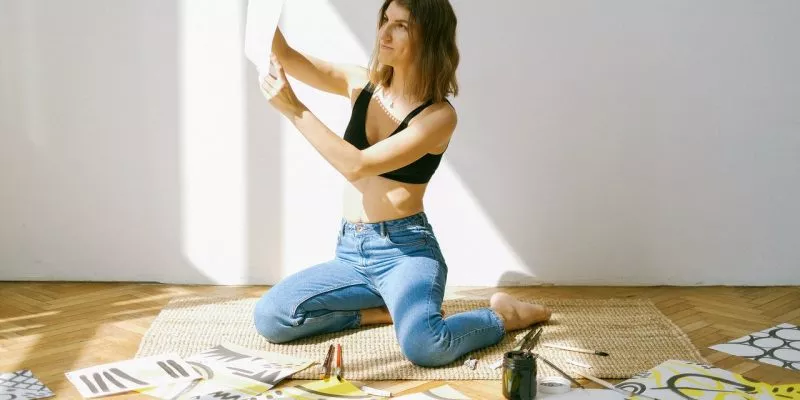If you’ve ever been interested in exploring your artistic side through painting, you may want to consider acrylic as your starting medium of choice. Not nearly as expensive as oil or as unforgiving as watercolor, acrylic paint is an easy medium to learn and it only requires minimal and easily sourced materials to get started.
One of the five most common paint mediums used by artists, acrylic paint is surprisingly beginner-friendly. With some dedication, a little training, and a lot of enjoyable practice, you could be well on your way to producing masterpieces in your spare time. At the very least, you would have found yourself a pleasurable and productive creative outlet.

Myths that hold you back
Given that there are so many people who enjoy and appreciate art and artistic expression, it comes as something of a surprise when you find out that there are very few non-professionals who feel confident in taking up a brush themselves. They can come up with the strangest reasons to justify keeping themselves from something they want to do, too!
Keep in mind, though, that whether you believe you can or you believe you can’t, you’re right.
“I don’t know how to do that (paint)”
Although children take to painting naturally, it’s not because they already know how to do it. It’s because they aren’t putting too much pressure on themselves and they are surrounded by the support of their peers and their caretakers. They simply allow themselves to explore and learn.
Were you born knowing how to do your taxes, ride a bike, or drive a car? Of course not. Similarly, Nobody springs forth from the womb knowing what brush strokes create the best effects, or how to choose which colors convey what feeling.
The good news is that given the right circumstances, anything can be learned, and painting is a relatively easy skill to acquire.
“I won’t be any good”
That reasoning has never stopped anyone who was really determined and it shouldn’t stop you. Besides, “good” is always subjective, and art is an ambiguous topic, to begin with. If it allows you to have fun and express yourself, you shouldn’t have to be “good” for anyone but yourself. Tell your inner critic to take the day off and just let yourself paint.
“I don’t have any time to paint”
A lot of people will argue that taking time to do something you enjoy is self-care, and they would be right. Besides, you don’t need chunks of time to learn how to paint. You can set twenty minutes aside in your lunch break to read up on acrylic painting tips or spend a couple of hours on a lazy Sunday indulging in your hobby.
Science might even argue that if you keep neglecting yourself by running yourself ragged by chasing after pressing and stressful tasks without taking a break, the costs on your mental and even physical health may force you to stop anyway.
New skills help keep your mind active and flexible. Hobbies are good for your mental health and seeking out a little bit of time is good for you, and the people around you, hands down.
“There’s no space in my home for me to take up a hobby”
Happily, acrylic painting doesn’t need a lot of space initially. Just a few pencils, the basic colors of student grade paint, a small easel, and some paper - all of which will fit on any table in the house that you eat off of, and stow away in a box in the closet or under your bed.
“I’m too old to learn a new skill”
As long as you can pick up a brush, and you have the inclination to paint, you are never too old to learn how to paint.
Grandma Moses is a famous contemporary artist whose paintings are increasingly in demand. Her more pieces are showcased in the Metropolitan Museum of Art in New York, the Art Institute of Chicago, and the Phillips Collection in Washington, D.C. Some of her paintings are highly coveted and are priced at upwards of USD 1M.
She was also so prolific that she painted until the last few weeks of her life, at 101. But her long life wasn’t why people call her Grandma Moses (her real name was Anna Mary Robertson Moses). It was because she reached the height of her career as a painter when she was in her 80s, having begun learning to paint at 76 years of age.
Happily, acrylic painting doesn’t need a lot of space initially. Just a few pencils, the basic colors of student grade paint, a small easel, and some paper - all of which will fit on any table in the house that you eat off of, and stow away in a box in the closet or under your bed.
Know your starting point
So you’ve made up your mind and are determined to start on your painting journey. What do you need to actually make your first painting?
Must-have supplies
These are items that you must absolutely have before you sit down to paint. While it’s generally a rule to invest in items that are of as good a quality as you can afford, you may want to get just the basics when you’re a beginner.
Don’t shy away from second-hand supplies, especially when it comes to brushes and paints. Remember to keep an eye on hobbyist destash groups for bargains, especially online!
- Acrylic paint. Usually sold in tubes, acrylic paint comes in student grade, craft grade, and professional grade. As you go up grades, the texture and pigmentation of the paints improve. The lightfastness and archival quality of the paints also improve. Every improvement comes with an according increase in price, and if you’re a brand new acrylic painter just learning the ropes, you may want to stick to student grade paints in the basic colors. Resist buying specialty paint like metallics and shimmery paints. This is so that you don’t end up with a ton of expensive paints in colors you don’t even want to use, and still end up wanting to buy other kinds. As you grow in your new hobby, you will find what you like and better know which paints and which are best for your style.
- Paper. Sorry, but regular notepaper or cardstock won’t cut it. Acrylic paint is heavy and will require water and a solid base that won’t warp and tear under the weight and moisture. You can use mixed media paper which is available in most art supply stores, or thicker watercolor paper.
- Brushes. Buy only a couple of brushes to start, and make sure that they’re specifically for acrylic paint. You may be tempted to get more popular brands, but one or two mid-range brushes are really all you need to practice your basics. You can get more and better ones once you feel comfortable with how you grip and manipulate your first brushes.
- Water. Any tap water that isn’t obviously muddy, contaminated, or dirty will suffice. Put them in two containers: one for rinsing your brushes out, and the other to wet your paints and brushes.
Nice-to-have supplies
- Gesso. Used for priming your canvass.
- Canvas and frames. A step up from paper, these materials give an extra level to your artwork and make it easier to be displayed.
- Paint extenders. There are pastes that create volume and texture for acrylic paint artwork, and they are extra fun to work with. Some give your paint a gloss, or the texture of sand, or even metallic sheens.
- Sealants. Not always necessary, but helpful in preserving your masterpieces for future generations.
Where to learn helpful acrylic painting tips
There is no limit to places where one can find inspiration and instruction when it comes to working with acrylic paints. You may not even need to ever leave your home and you can still learn, create, and share with a vibrant, interactive community that supports and encourages your love of acrylics.
Bloggers and vloggers
Experts and artists have taken to the internet to showcase their works, share helpful tips, and even mentor aspiring artists. They are also a relevant and necessary source of product reviews and information, especially for beginners. Check out YouTube channels, Instagram, and yes, even Tiktok.
Paid classes
While there’s a lot you can learn on your own for free, you can find invaluable lessons being tutored one on one or as part of a group in a paid class. These can be live in local schools or online.
Product blogs
Who better to teach you how to use their products but the manufacturers themselves? Most of the time manufacturers have artists and experts do demos where they explain the advantages and disadvantages of the product and you can learn the different techniques that show off the product, in this case, anything from acrylic paint to brushes and even canvasses, water buckets, and sponges, to papers and canvas.
Hobbyist groups
There are various hobbyist groups on social media that you may join to learn various acrylic painting tips from beginners who have made their own mistakes and learned their lessons and are only too happy to share.


